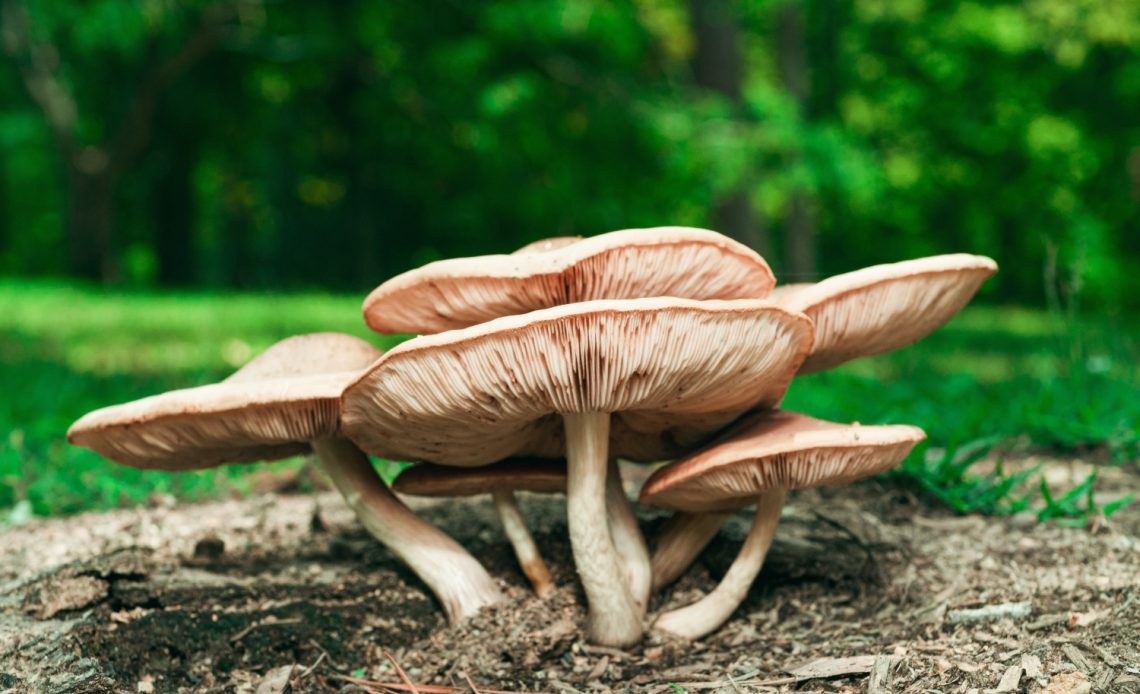

We’re here to help! Wild Yards is a completely free website that is 100% dedicated to helping you create a wildlife-friendly, sustainable yard. Read more
WildYards is reader-supported. When you buy a product through a link on our site, we may earn a comission. Every product is independently selected by our (obsessive) editors and our reviews are unbiased and objective. Read more about our mission or our privacy policy.
You wake up one morning and peek out of your front window, ready to take on the day, only to find a giant mushroom growing up from your lawn, sticking out like a dirty spot on a white rug. Mushrooms are a common problem for homeowners, and these unsightly fungi can be incredibly frustrating to deal with. If you want to learn how to get rid of mushrooms in your yard, and if you’d like to know just why they’re growing in the first place, we’re here to help!
Mushrooms are a sign that your yard has healthy soil that’s rich in moisture-retaining organic matter. If you want to get rid of the mushrooms in your yard, dethatching your lawn, aerating the soil, using fungicides, and applying fertilizers that are high in nitrogen will help prevent them from popping up.
Why are mushrooms growing on your lawn?
As the old saying goes, “know your enemy”. If you want to get rid of the mushrooms that are ruining your manicured landscaping, you’ve got to know why they’re coming up in the first place.
Mushrooms thrive in moist soils that are rich in decaying organic matter. They prefer to grow in low-light conditions, and so are more prevalent in shady locations. They may still come up in sunny yards, although they usually have a shorter life cycle as most mushrooms can’t withstand direct sunlight for very long.
Mushrooms are most likely to sprout up after rain or excessive watering. You’re also more likely to see mushrooms in areas where dead vegetation has been allowed to build up — around old lawn clippings and dead leaf piles, for instance.
Mushrooms are also a common fixture near decaying wood. Old tree stumps and half-rotting wood stacks are perfect places for mushrooms to grow. If you’ve used landscape timbers as a border for your garden or flower beds, you’ll likely find mushrooms around them as they decompose.
Are mushrooms actually a good thing to have?
Mushrooms may be an eyesore, but they’re a sign that your yard is in great shape. See, mushrooms only grow in moist areas where the soil is full of nutrient-dense organic matter. These fungi are nature’s decomposers, turning large pieces of decaying material into the broken-down nutritional building blocks that the plants in your yard need to thrive.
Plants and mushrooms share a symbiotic relationship. Most mushrooms are obligately symbiotic, meaning they rely on help from neighboring plants to survive. Mushrooms produce mycorrhizae, or fungal roots, that latch onto the roots of surrounding plants. This enables the plants and the mushrooms to share resources, with mushrooms providing the plants with nutrients, and the plants providing the mushrooms with carbohydrates needed for energy.
So when you see mushrooms sprouting up all over the place, frustrating as it is, it’s a sign that your lawn has excellent soil, and they aren’t doing your yard any real damage.
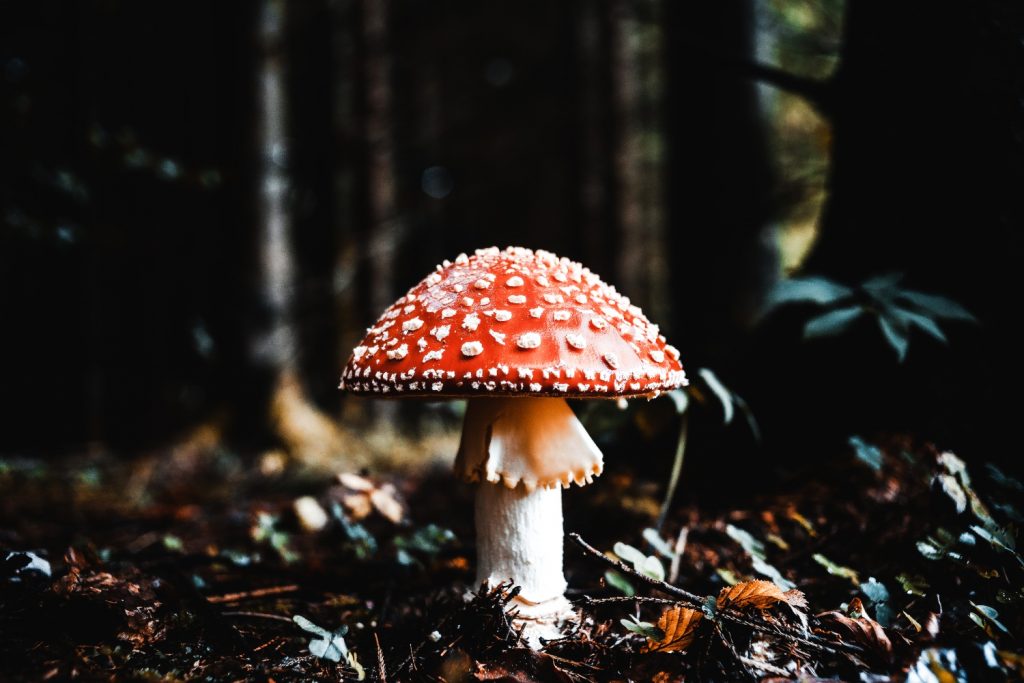
How do mushrooms spread?
Each mushroom grows from a single spore. When a spore lands in a nice moist location where there’s plenty of food, it germinates, producing hyphae. These long branching filaments absorb nutrients from the soil and promote vegetative growth. Hyphae are similar to plant roots in both function and appearance.
As hyphae grow and mature, they become a large web-like structure. This tangled mass is called mycelium, and when conditions are right, the mycelium will obtain enough nutrients from decaying materials in the soil to turn into a mushroom.
The mushroom you see in your yard is the result of a large network of fungi living beneath the soil. The mushroom itself is simply the resulting fruit of that structure. Most mushrooms found in lawns and gardens only live for a day or so, but some mushrooms can last for months.
Once the mushrooms begin to break down, they release spores, even generating their own wind to carry the spores away. Spores that land in less-than-ideal spots can remain dormant for months until conditions improve.
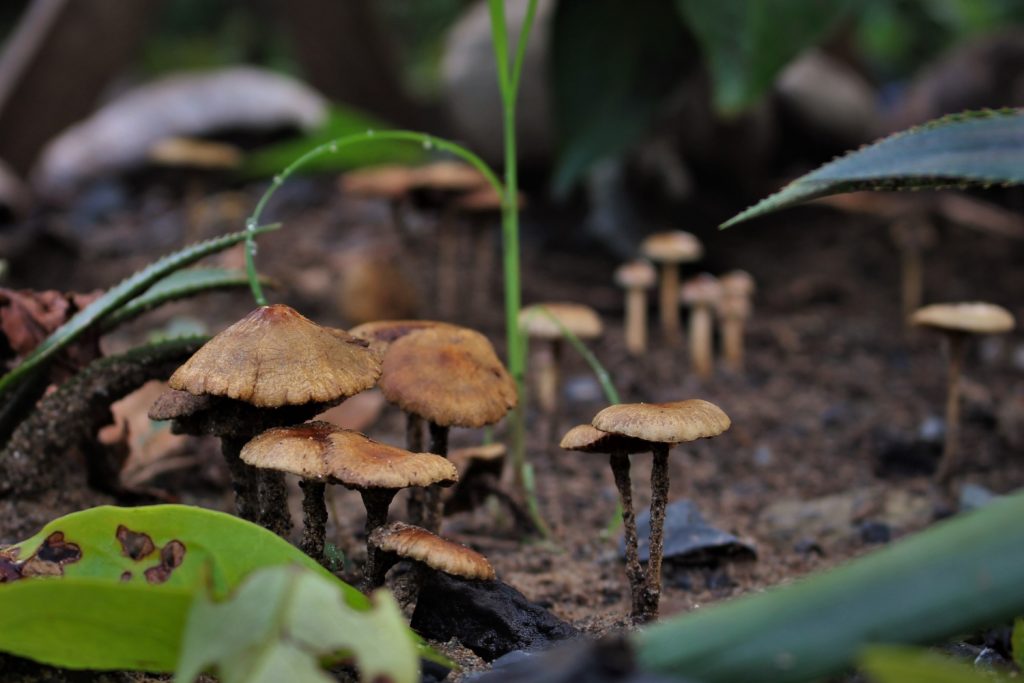
How fast do mushrooms grow?
If it seems like the mushrooms in your yard have sprouted up overnight, that’s because they probably did. Depending on conditions, it can take weeks to months for hyphae to turn into a mycelium capable of producing a mushroom. But once the mushroom begins, it takes very little time for it to develop.
Small mushrooms can erupt from the ground in just 24 hours. Medium and large mushrooms take a bit longer, maturing in 3 to 4 days. Rainfall, nutrient availability, and temperature all factor in when it comes to mushroom growth. Fortunately, mushrooms are pretty short-lived and usually disappear just as fast as they appear.
Are lawn mushrooms hazardous to your health?
Of the 10,000 species of mushrooms found worldwide, only 50 to 100 of them are poisonous. So the vast majority of mushrooms found in lawns and gardens are not harmful. While you should always wear gloves, goggles, and a mask when handling mushrooms, it probably won’t hurt you if you accidentally touch one. Just be sure to wash your hands in cool water shortly afterward.
That said, you should never eat the mushrooms that you find in your yard unless you know good and well which ones are edible and which ones are not. While most garden mushrooms won’t hurt you if you touch them, they may still be toxic if ingested. Toxic mushrooms are called toadstools, and usually have a strong foul odor to encourage foragers to stay away.
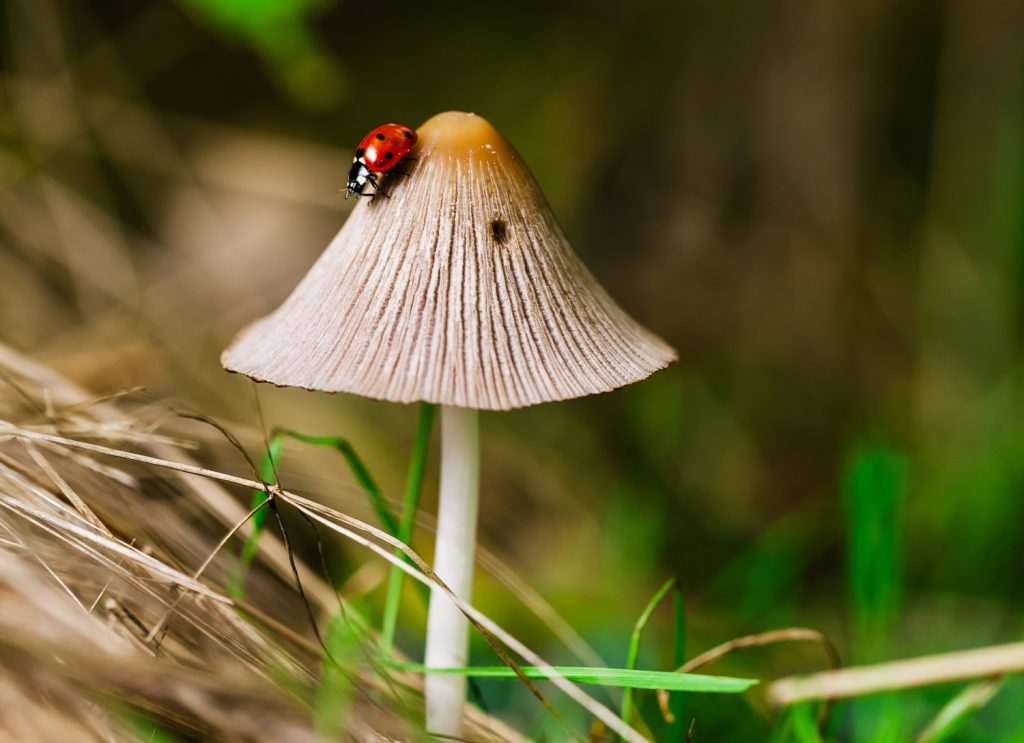
Can lawn mushrooms be harmful to pets?
Yes, potentially. Mushrooms that are toxic to people are just as toxic to cats and dogs, and your pets may die if they ingest one. If your four-legged friend has a bad habit of eating things they shouldn’t, keep a careful eye on them when they’re outside — especially after rain. Consider buying them a muzzle to wear when they’re outdoors to prevent them from snacking on poisonous substances. Taking the necessary steps to eliminate the mushrooms growing in your yard is the best way to keep them safe.

Which mushrooms are you most likely to see growing in your yard?
Mushrooms spread by releasing their spores, which means new mushrooms can sprout wherever the wind takes them. You could find any number of different kinds of mushrooms out in your yard. But you’re most likely to see one of the following.
Haymaker mushroom
Thin, spindly mushrooms that are also known as mower’s mushrooms, haymakers are gray-brown with stems growing 3 inches long and caps reaching 1.5 inches in diameter. Although these mushrooms aren’t truly poisonous, they’re inedible, so it’s best to remove them from your lawn when you see them.
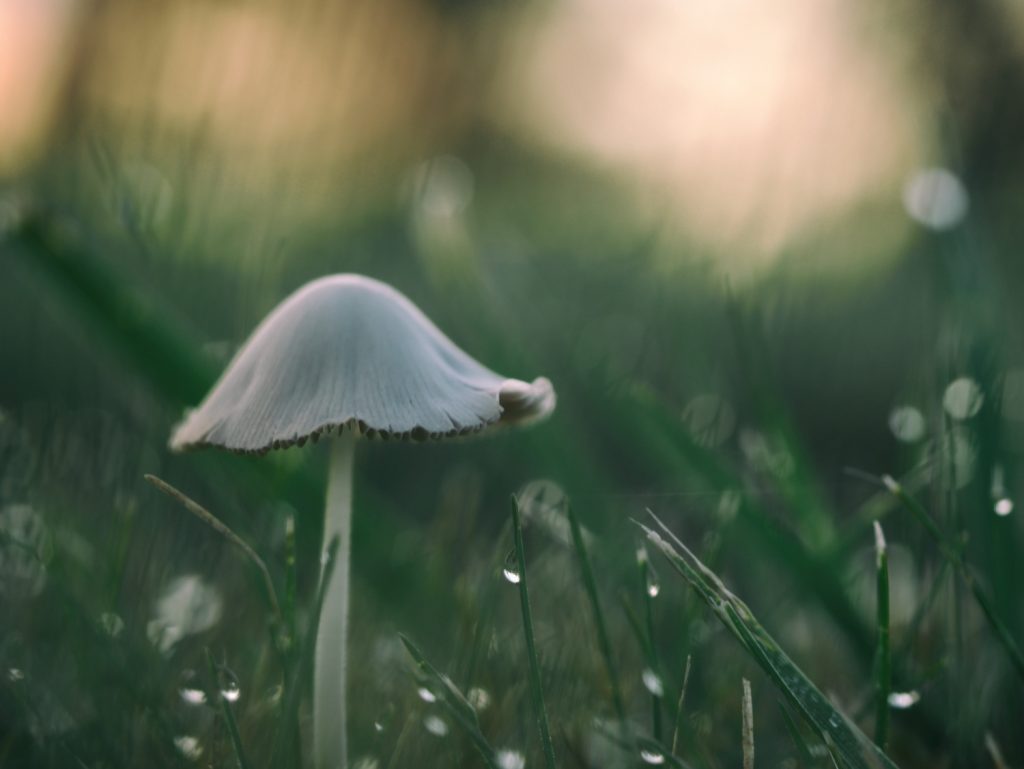
Destroying angel
Yikes! With a name like that, you know this mushroom is bad news. The destroying angel can often be found growing at the base of oak trees, where they grow roughly 10 inches tall and 5 inches wide. These mushrooms are uniformly white, with caps turning slightly off-white as they mature. Stalks have a shaggy texture. These mushrooms usually sprout up in late summer to fall and should be removed promptly.
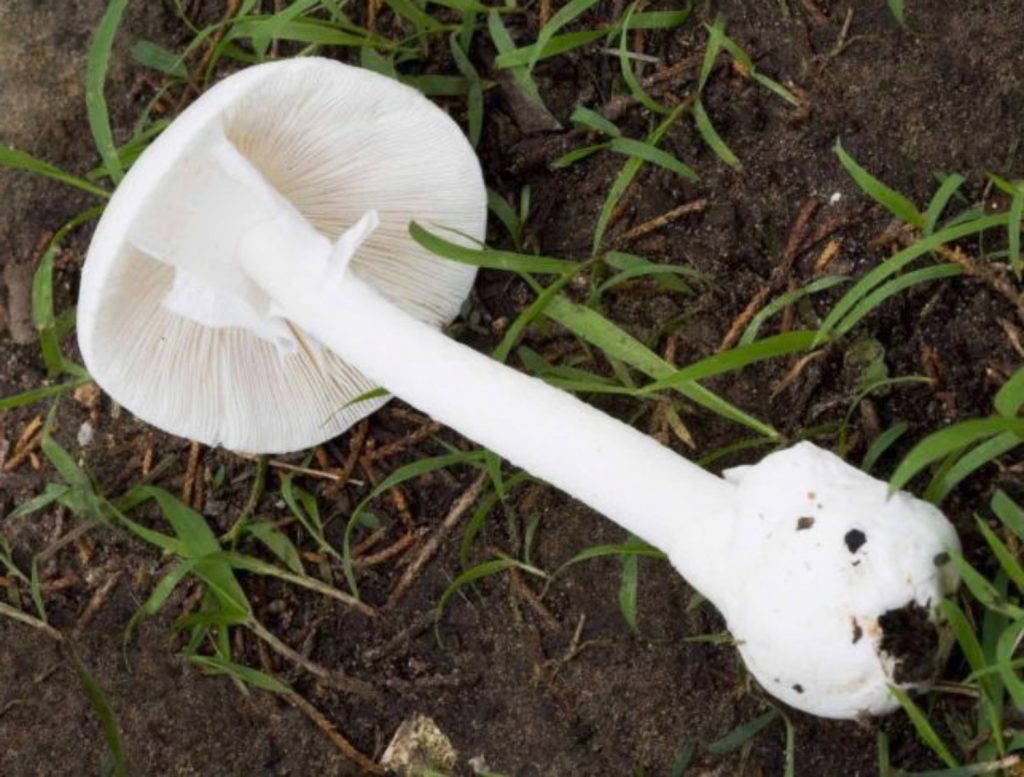
Meadow mushroom
These 2-inch creamy white to tan colored mushrooms have tall caps and relatively short stems. Peeking beneath the cap, you’ll see the meadow mushroom has brown gills. These mushrooms measure up to 4 inches in diameter, and even though they’re edible, they can be confused with other more toxic mushrooms, including the destroying angel.
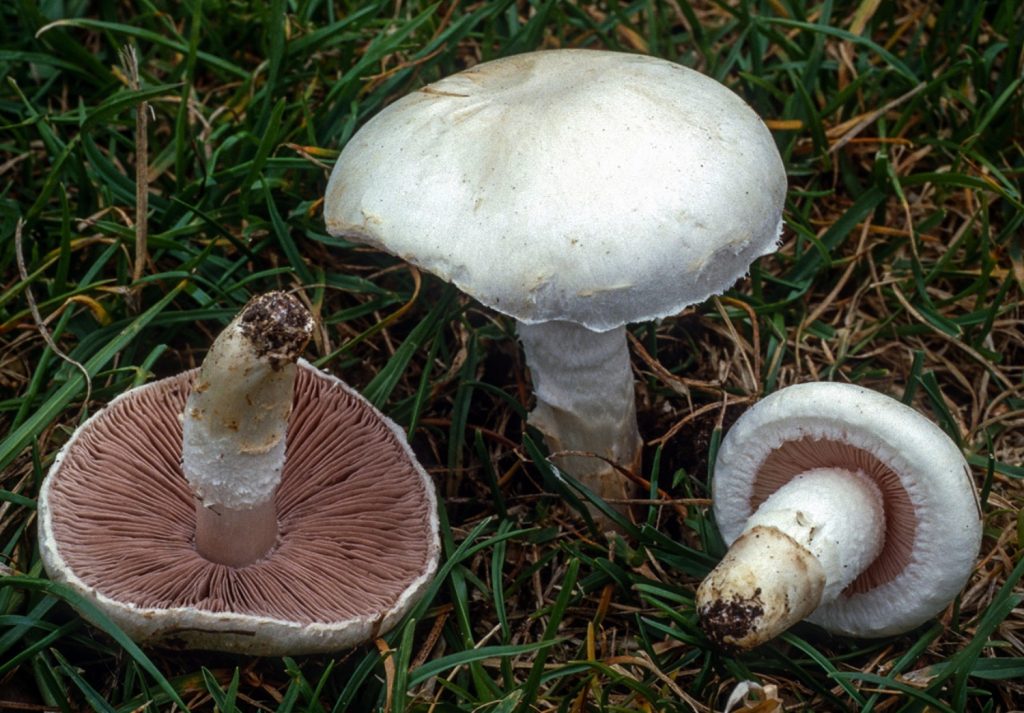
Puffball
The aptly named puffball mushroom is one of the easiest to identify. These mushrooms vary in size, but are white to tan and have a round or oval shape. You may mistake one for a bird egg. As these mushrooms mature, a hole develops in their tops, allowing the spores inside to escape. If you step on a puffball prematurely, you’ll hear a muted “pop” and see what looks like smoke erupting beneath your shoe.
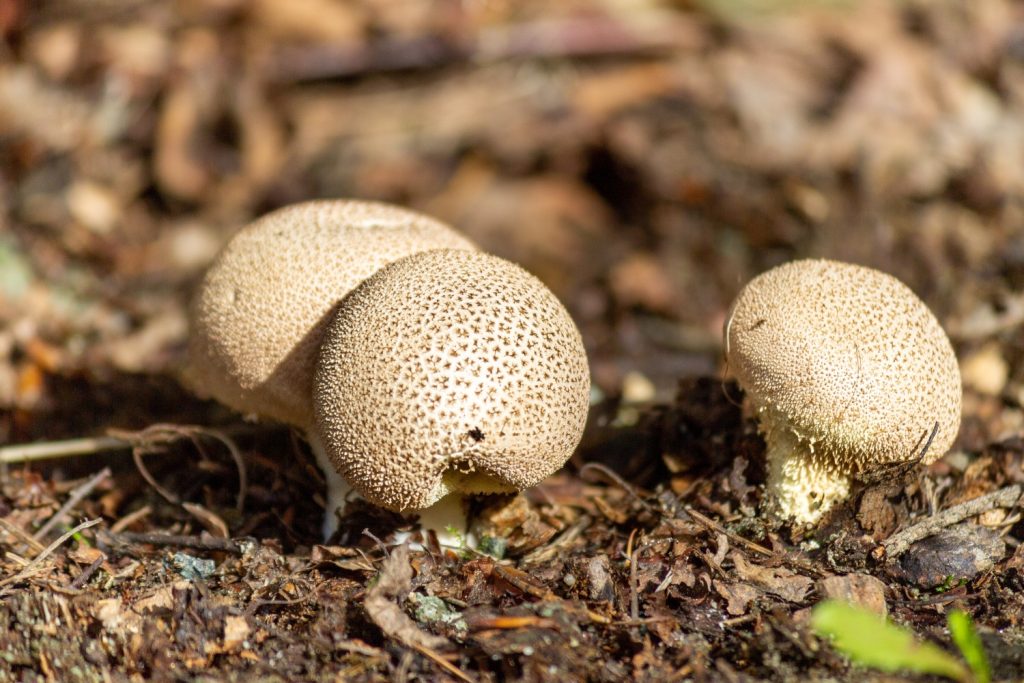
Vomiter
The majority of mushroom poisoning cases in the U.S. can be chalked up to this mushroom right here. The vomiter. These benign-looking mushrooms have white stalks and light brown caps with a scaly texture. They vary in size, ranging from 2 to 10 inches tall and 2 to 12 inches wide. As the name implies, the vomiter mushroom causes excessive vomiting when ingested, so be sure to pluck these suckers out of your lawn.
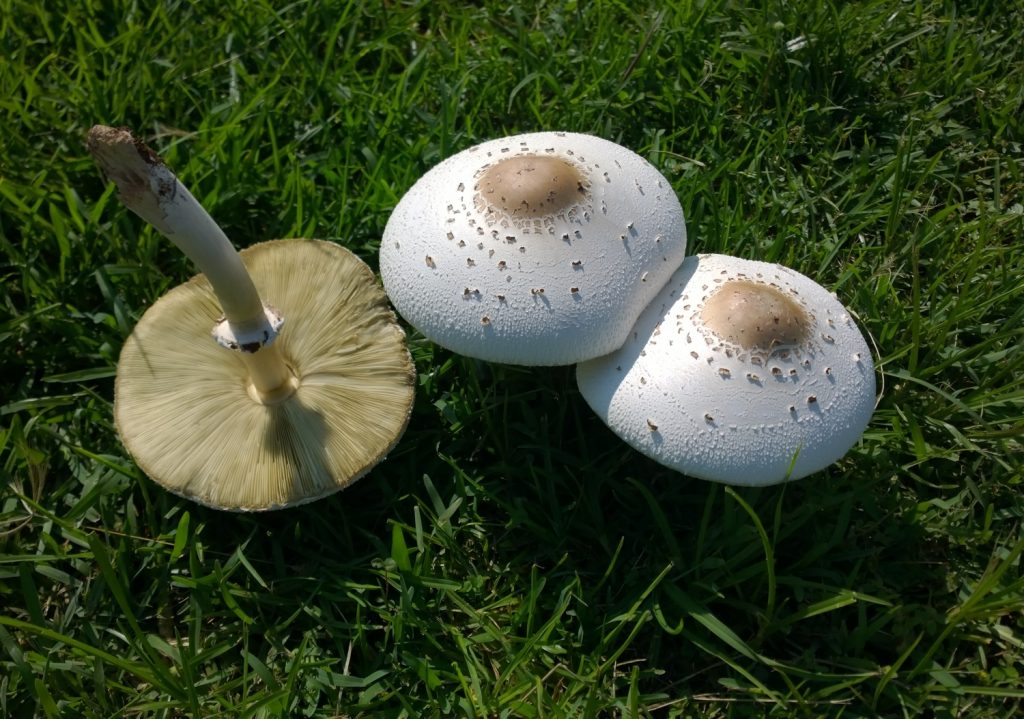
Fairy ring
These mushrooms grow around 3 inches tall by 2 inches wide, and are white to brown in color, growing darker as they age. Fairy rings tend to grow in networks, with mushrooms sprouting in an “enchanting” circle. While fairy ring mushrooms are notorious for growing in circles, many other mushrooms can grow this way, too, and when they do, the resulting ring is also called a fairy ring.
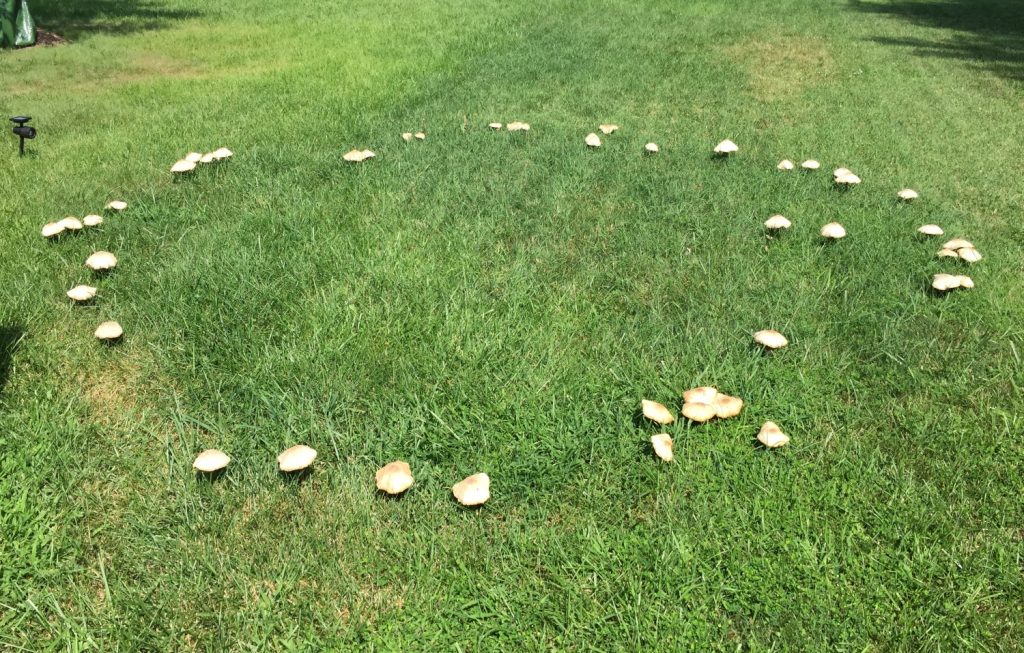
How to get rid of the mushrooms growing in your yard
If you want to get rid of the mushrooms in your yard, you’ve got to make it less hospitable to them. Even though mushrooms can sprout up overnight, their intricate framework of mycelium has likely been residing in your soil for months. Removing mushrooms takes hard work and vigilance, and you may never be able to completely remove them. You can, however, drastically reduce the number of mushrooms you see in your yard by taking the following measures.
Dethatch your lawn
Dethatching is the process of removing the layer of dead grass, leaves, twigs, and weeds (called thatch) from between the uppermost layer of soil and the bottommost layer of grass.
A thin layer of thatch can be highly beneficial to your lawn because it locks in hydration and enriches the soil as it breaks down over time. But when thatch is too dense, it blocks out the sunlight, trapping heat and moisture and creating an ideal environment for mushrooms to grow.
Dethatching is a back-breaking job, but it’s one of the most effective means of getting rid of mushrooms — especially when you apply a fungicide afterward (more on that in a minute). You can dethatch your lawn by using a dethatching rake to pry the thatch up and away from the lawn.
Removing thatch allows oxygen and sunlight to penetrate the soil below. This keeps the soil dry making it a much less suitable environment for mushrooms. Take this opportunity to remove any piles of lawn trimmings, dead wood, and other decaying matter from your lawn, as these are also potential breeding grounds for mushrooms.
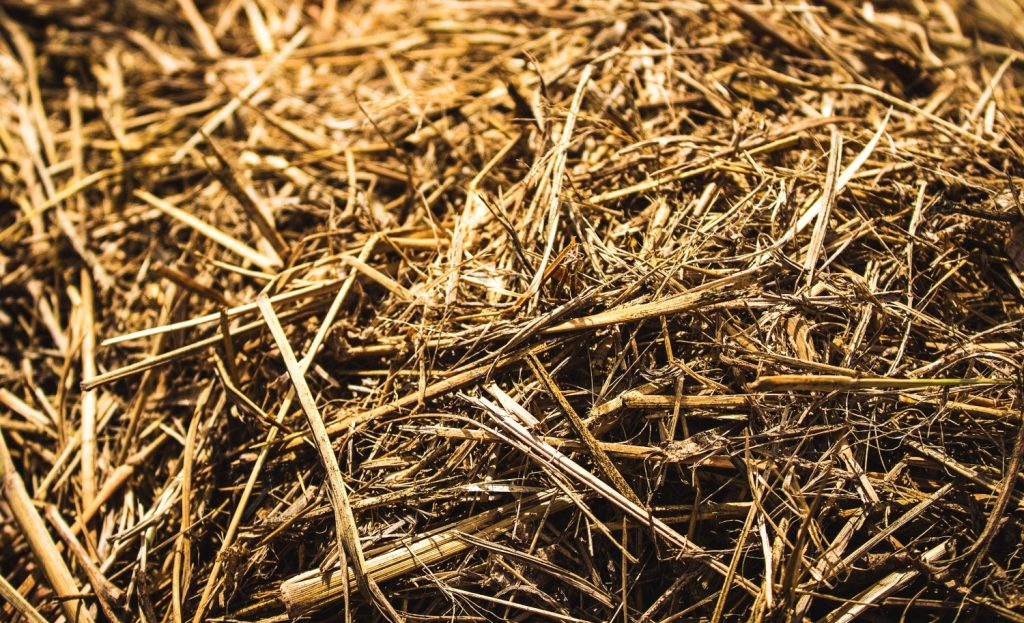
Aerate your lawn
Like dethatching, aerating your lawn makes it easier for oxygen to penetrate, which in turn helps keep the soil dry. You can aerate your yard with a handheld aerator or by strapping on a pair of aerator shoes and walking around. If you have a large property, consider investing in a tow-behind lawn aerator to attach to your riding mower or four-wheeler.
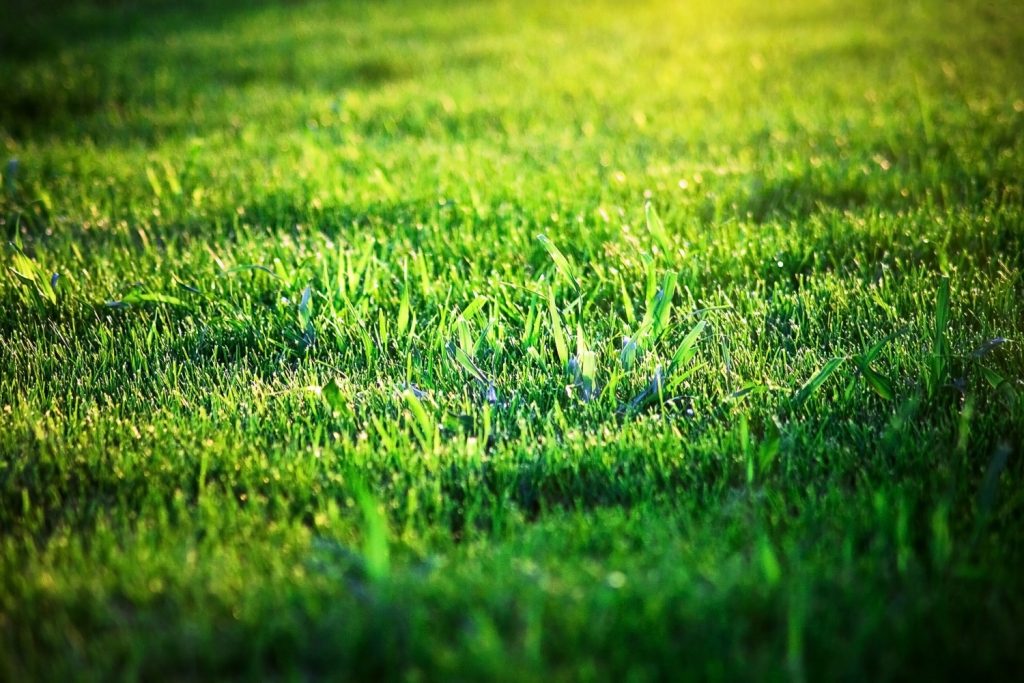
Spray a fungicide
Fungicides can be pretty hit or miss when it comes to mushrooms. While fungicides are designed to kill fungi by preventing them from reproducing and neutralizing spores, they may not be able to kill the whole fungus if you only spray them on the mushrooms.
Fungicides are most effective when applied shortly after aerating your lawn. This gives the fungicide a direct route to the mycelium, where it can go to work. When used correctly, a commercial fungicide can make a huge difference in mushroom populations, especially when they’re applied after dethatching.
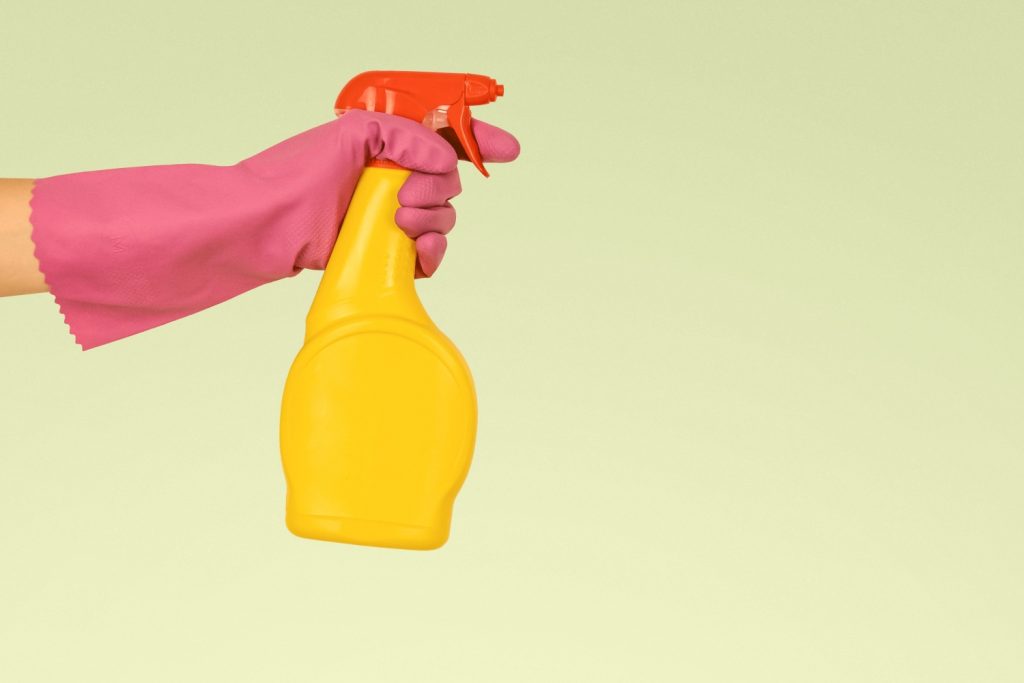
Use vinegar
If you’d rather not use a chemical fungicide to eliminate the mushrooms growing in your yard, you can always try vinegar. The acetic acid in vinegar is known to kill bacteria and fungi, which is why it’s such a popular cleaning agent. Use a dilution of 5 tablespoons of vinegar to a gallon of water to spray your lawn, being careful to go over any place where mushrooms are most likely to grow.
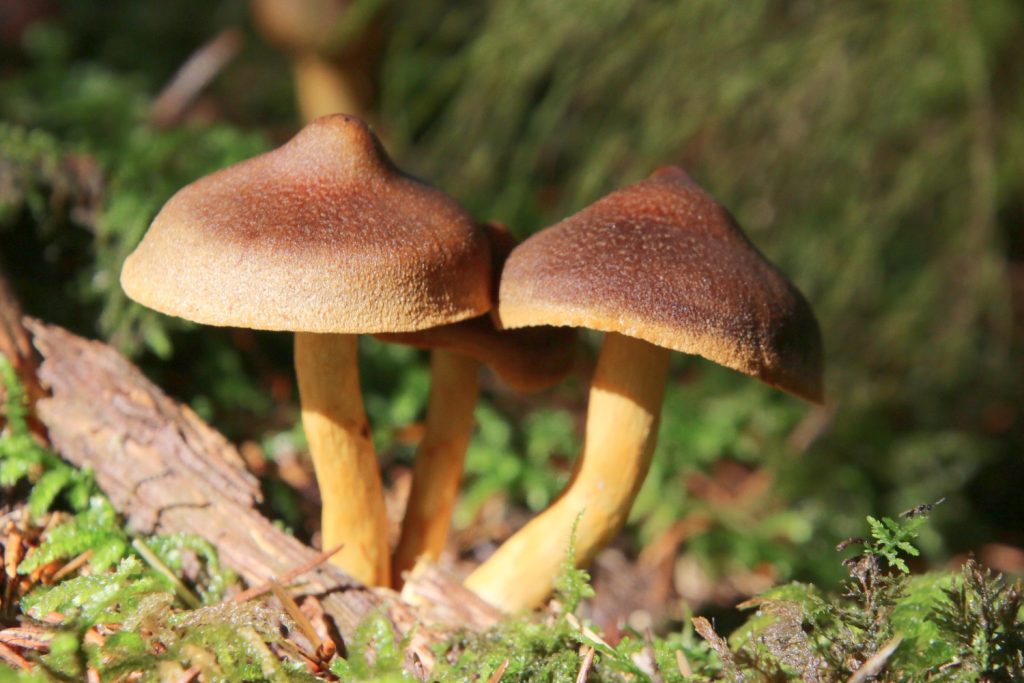
Don’t overwater
One of the easiest ways to prevent mushrooms from growing in your yard is to water sparingly. Overwatering makes your soil a perfect home for mushroom spores to sprout in. By simply restricting water usage, you can greatly reduce the number of mushrooms you see on your lawn.
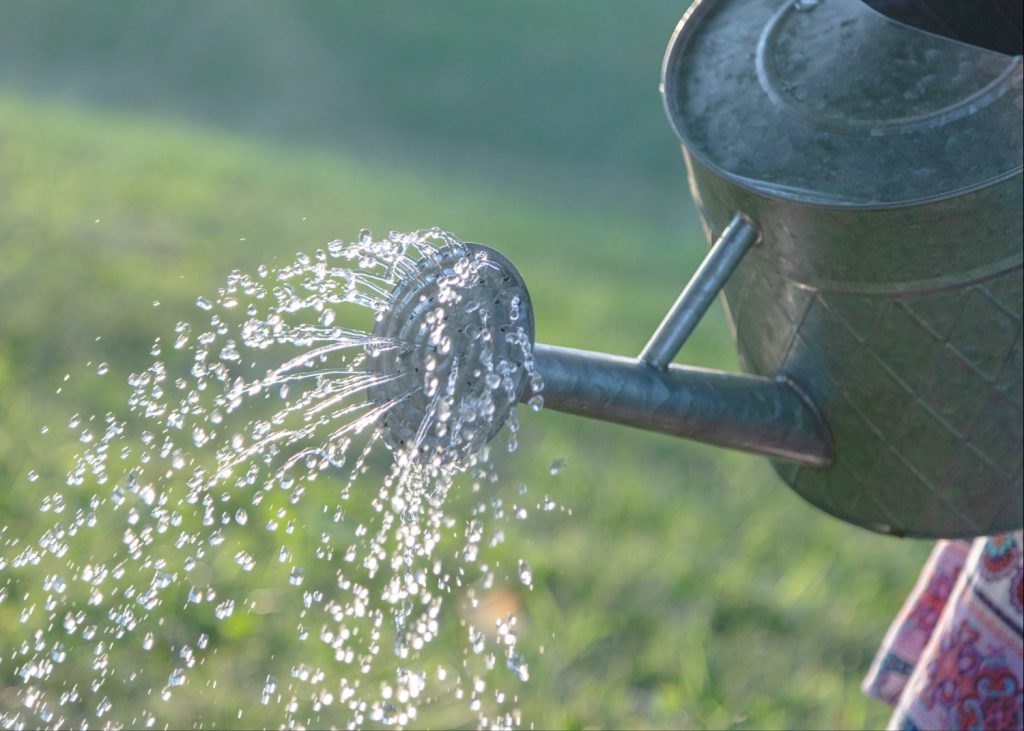
Trim your trees
If you have a shady yard, your soil will hold onto moisture, even if it drains well otherwise, purely because the sun can’t reach the ground. Thinning out your trees by removing a few branches helps sunlight penetrate more easily. Remember, mushrooms grow best in low light conditions, so making sure your lawn gets plenty of sunshine is an easy way to keep them at bay
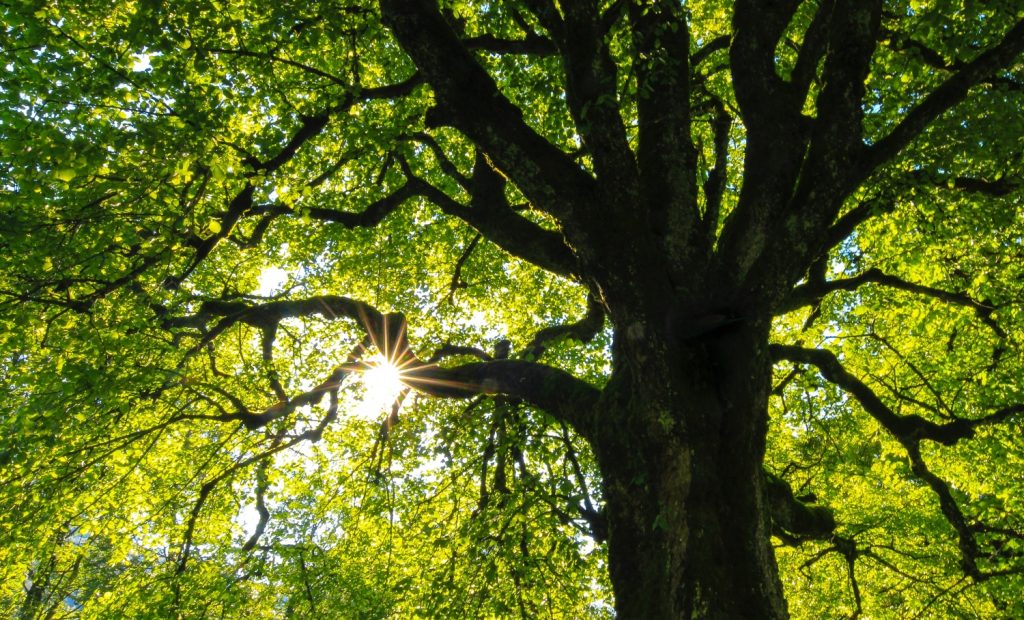
Apply a nitrogen-rich fertilizer
Nitrogen doesn’t actually kill mushrooms. But it does result in a rapid increase in nutrient absorption, making mushrooms sprout up faster, and die off quicker. Using a nitrogen-rich fertilizer, like Nitroform (39-0-0) or even blood meal (13-0-0) can cut your mushroom problem short by hitting the fast-forward button on their life cycle.
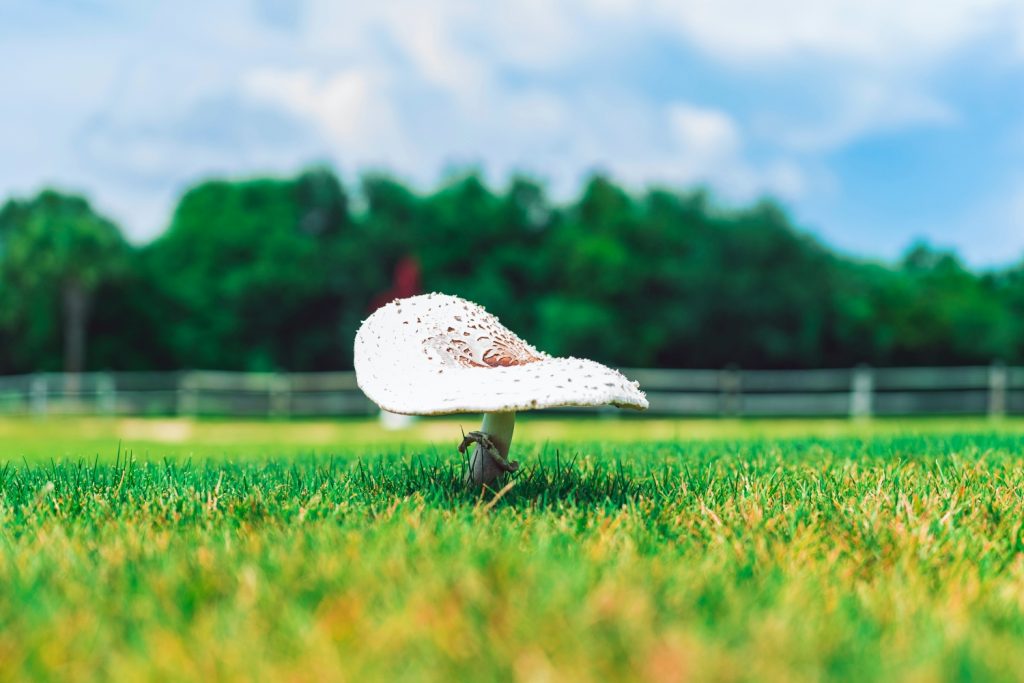
Use baking soda
This method is especially effective on mushrooms that have overtaken the mulch in your flower beds. Simply stir a tablespoon of baking soda into a gallon of water and spray it over the mulch. This will help kill the mushrooms and prevent new ones from popping up.

Dig them up
If all else fails, you can always remove the mushrooms by hand. Remember to wear long sleeves, long pants, and gloves when doing so to prevent potentially hazardous spores from coming into contact with your skin. You should also wear goggles and a mask to keep spores out of your sinuses. Even if the mushroom spores aren’t toxic, they can still cause allergies.
It’s best to remove mushrooms shortly after they come up. Picking matured mushrooms stirs up spores, and that’s the last thing you want if you’re trying to get rid of them.
Use a hand trowel to dig up the mushrooms, placing them in a plastic Ziploc bag as you go. It’s important to seal the mushrooms so they don’t release their spores. Never add mushrooms to your compost heap. Using spore-ridden compost to feed your plants would only perpetuate the problem.
Apply a fungicide to the inside of the hole before filling it in to kill the mushroom’s mycelium. You can also use a mixture of water and dish soap to kill off the fungi. Use enough water to fill the plug and 2 to 4 drops of the dish soap of your choice.
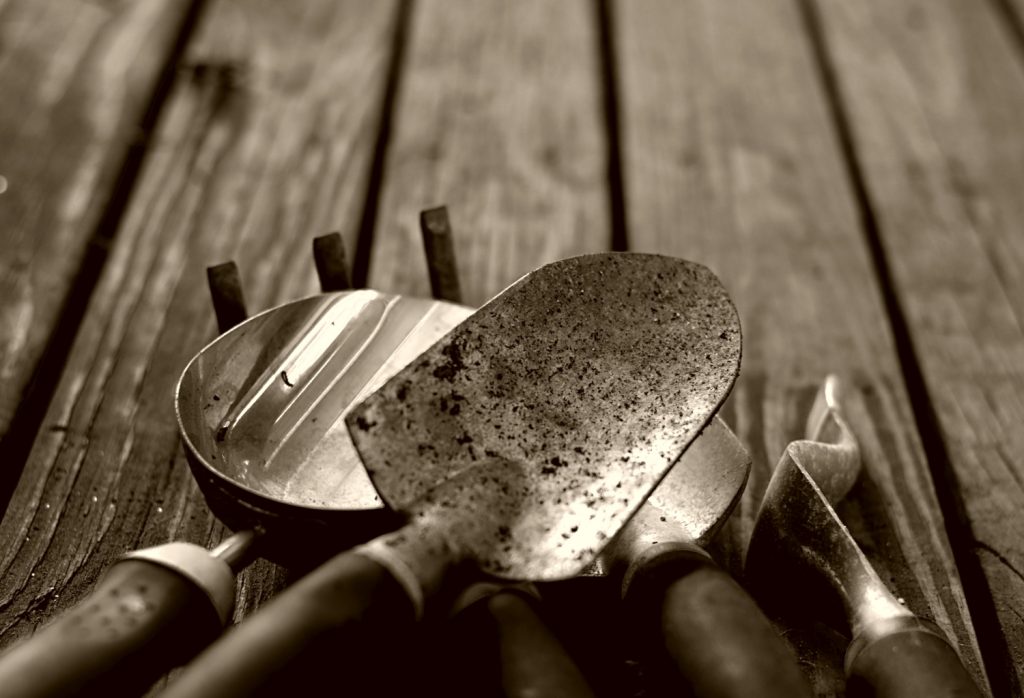
Do you have to get rid of the mushrooms growing in your yard?
Mushrooms can be a blight on a well-maintained lawn. If your yard is your pride and joy, you may want to remove every mushroom in sight as quickly as possible. But, ugly as they may be to some people, mushrooms are actually highly beneficial. Their symbiotic relationship with the plants in your yard enables them to break down nutrients, keeping your garden healthy and beautiful, and potentially cutting down on fertilizer costs over time.
If you’re happy to let the mushrooms on your lawn stay right where they are, consider giving your yard back to nature by re-wilding your lawn. Otherwise, with the help of these de-mushrooming strategies, you can get rid of these pesky fungi and get back to enjoying your pristine landscaping.
